
Dosso Dossi was an Italian Renaissance painter who belonged to the School of Ferrara, painting in a style mainly influenced by Venetian painting, in particular Giorgione and early Titian.

Jesi, also spelled Iesi, is a town and comune of the province of Ancona in Marche, Italy.

Palazzo Schifanoia is a Renaissance palace in Ferrara, Emilia-Romagna (Italy) built for the Este family. The name "Schifanoia" is thought to originate from "schivar la noia" meaning literally to "escape from boredom" which describes accurately the original intention of the palazzo and the other villas in close proximity where the Este court relaxed. The highlights of its decorations are the allegorical frescoes with details in tempera by or after Francesco del Cossa and Cosmè Tura, executed ca 1469–70, a unique survival of their time.

Gualtieri is a comune (municipality) in the Province of Reggio Emilia in the Italian region Emilia-Romagna, located about 70 kilometres (43 mi) northwest of Bologna and about 25 kilometres (16 mi) north of Reggio Emilia on the right bank of the Po River. Historically, it suffered numerous floods, the last occurring in 1951.

Giovan Battista Aleotti was an Italian architect.
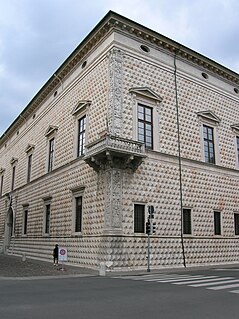
Palazzo dei Diamanti is a Renaissance palace located on Corso Ercole I d'Este 21 in Ferrara, region of Emilia Romagna, Italy. The main floor of the Palace houses the Pinacoteca Nazionale di Ferrara.

Bonifazio Bevilacqua Aldobrandini was an Italian Cardinal. He was the uncle of Pope Gregory XIV.

Palazzo Spini Ferroni is a large Gothic palace located along Via de' Tornabuoni at the corner of Piazza Santa Trinita, in central Florence, region of Tuscany, Italy. It stands across from the church of Santa Trinita.
The Biblioteca Comunale Ariostea is located in the Palazzo Paradiso in central Ferrara, region of Emilia-Romagna, Italy. It was named Ariostea, because the collection contains manuscripts related to the author, and within the palace also lies the tomb of Ludovico Ariosto.

The Palazzo Estense is a Baroque palace built for Francesco III d'Este and the House of Este in Varese, Italy.

The Galleria Estense is an art gallery in the heart of Modena, centred around the collection of the d’Este family: rulers of Modena, Ferrara and Reggio from 1289 to 1796. Located on the top floor of the Palazzo dei Musei, on the St. Augustine square, the museum showcases a vast array of works ranging from fresco and oil painting to marble, polychrome and terracotta sculpture; musical instruments; numismatics; curios and decorative antiques.
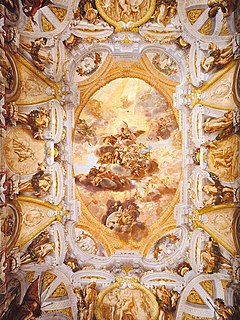
The Palazzo Pepoli Campogrande, also known as Palazzo Pepoli Nuovo, is a Baroque style palace on Via Castiglione 7 in central Bologna, region of Emilia-Romagna, Italy. In 2015, it served as a public art gallery for late-Baroque art. Across the Via, rises the medieval Palazzo Pepoli Vecchio, also once pertaining to the same family, which now serves as a museum of the history of Bologna.

The Palazzo Leoni Montanari is a late Baroque palace located in Contra’ San Corona number 25 in central Vicenza in the Veneto region of Italy. It now houses exhibition rooms, meeting places, and art collections owned by the bank Intesa Sanpaolo.

The Palazzo Zabarella is a medieval, fortress-like palace with a crenellated roof-line, and corner tower, located on Via San Francesco 27 in the center of Padua, Italy. The building now houses the Fondazione Bano, and serves as a locale for cultural events and exhibition.

The Palazzo Bentivoglio is a late-Renaissance palace located on Via Garibaldi in central Ferrara, Region of Emilia-Romagna, Italy

The Casino Mediceo di San Marco is a late-Renaissance or Mannerist style palace located on Via Cavour number 57 and via San Gallo in Florence, region of Tuscany, Italy.
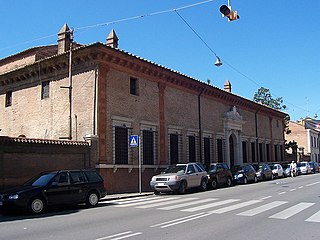
The Palazzina Marfisa d'Este is a Renaissance-style small palace, once suburban, and sometimes referred to as a villa, located on Corso Giovecca #170, just east of Central Ferrara, region of Emilia-Romagna, Italy. It was constructed in 1559 by the peripatetic Francesco d'Este, and inherited by his daughter, Marfisa in 1578.
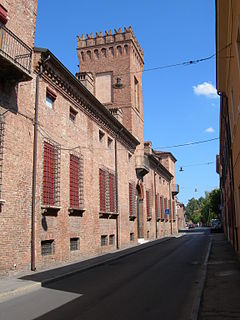
The Palazzo Bonacossi is a Renaissance architecture palace located on Via Cisterna del Follo #5 in Ferrara, Italy. The 15th-century palace is the home of the Musei Civici di Arte Antica e Museo Riminaldi.
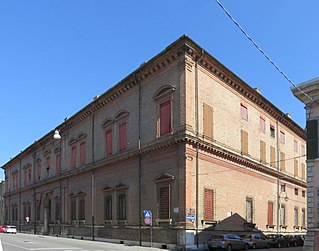
The Palazzo Massari, also known as the Palazzo Rosso, is a Renaissance-style palace located on Borso and Corso Porta Mare, at the northwest corner of Piazza Ariostea, in Ferrara, region of Emilia-Romagna, Italy.
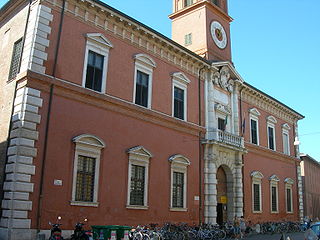
The Palazzo Paradiso is a Renaissance palace located on Via Scienze #17 in the medieval center of Ferrara, region of Emilia-Romagna, Italy. Adjacent to the historic Jewish ghetto of Ferrara, it houses:



















